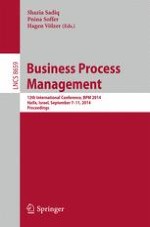This book constitutes the proceedings of the 12th International Conference on Business Process Management, BPM 2014, held in Haifa, Israel, in September 2014. The 21 regular papers and 10 short papers included in this volume were carefully reviewed and selected from 123 submissions. The papers are organized in 9 topical sections on declarative processes, user-centered process approaches, process discovery, integrative BPM, resource and time management in BPM, process analytics, process enabled environments, discovery and monitoring, and industry papers.
